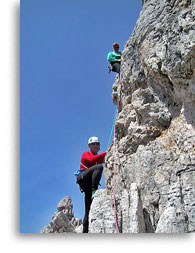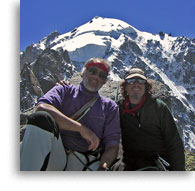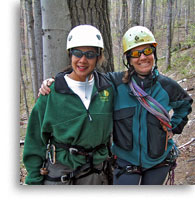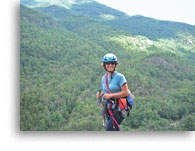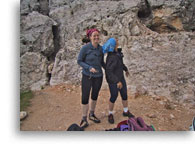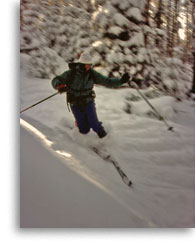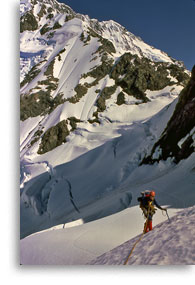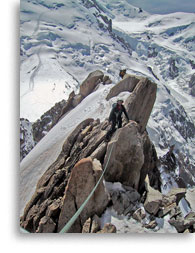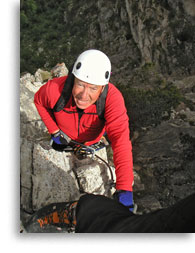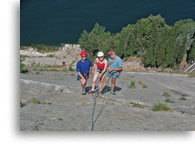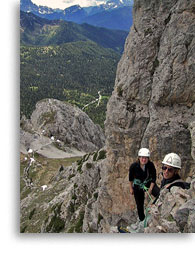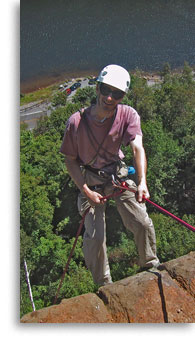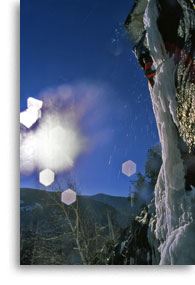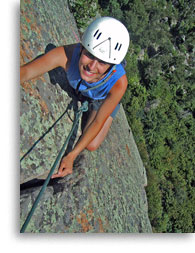
| Comparing Mountain Guides & Companies | |||||||||||||||||||||||||||||||||||||
|
|
Comparing services within the mountain guiding industry is not an easy task! With a manufactured product, which might be available from several different stores, you can compare prices, size up the merchant, and determine value relatively quickly and accurately. With mountain guiding services you are still faced with the task of comparing prices, but the “product” is different for each purveyor – sometimes immensely different. A slightly more expensive “product” that offers far more benefits is obviously a better value, but how do you determine what benefits you will receive? The sections below are intended to help you make an informed decision when purchasing mountain guiding services. We have attempted to be as objective as possible in presenting this information but it is ultimately based upon Our Values which tend toward personalized, high-quality, low-impact experiences. We hope the information below will assist you in making important decisions about the kinds of services you desire. We also hope it will help you ask the right questions so you can determine if you are likely to receive those services. No matter what choices you make, we suggest you “test the waters” with any company or guide before booking the trip of a lifetime. |
|
|||||||||||||||||||||||||||||||||||
|
You will need to look at several distinct aspects of mountain guiding to arrive at a useful picture for comparisons. |
|||||||||||||||||||||||||||||||||||||
| Types Of Services In the Mountain Guiding Industry | |||||||||||||||||||||||||||||||||||||
|
A wide variety of services can be found in today’s mountain guiding industry. A skilled guide can add a higher level safety and improved odds for success to most adventures. A talented instructor (commonly referred to as a guide) can help you master a wide variety of skills in the mountains. Often, seasoned guides will also provide an informed historical perspective, colorful entertainment, and camaraderie. Although there are myriad variations, and clear distinctions are not always possible, mountain guiding services fall broadly into the following categories: |
||||||||||||||||||||||||||||||||||||
|
Professional Mountain Guiding Professional mountain guiding, depending upon the objective, typically is conducted with one or two clients per guide. Occasionally, in less demanding environments, a third (and rarely a fourth) client may be added. Beyond four clients per guide, the compromises a guide must accept in terms of supervision and flexibility result in the more limited form of guiding we call a “supervised mountain experience”. Effective mountain guiding can only take place safely with clients who have already acquired essential skills for the chosen objective. In all cases basic skills are essential and, for more demanding objectives, advanced skills may be required. In other words, if you are a beginner you will need some instruction before you can be guided effectively and safely. Professional mountain guiding companies are in the business of helping you maximize your enjoyment of mountain activities. Depending upon where they operate and other factors, a company may offer a vast array of guiding services or just a few. A company that provides guided rock climbing on just one cliff, during six months of the year, is very different from one that guides all types of alpine activities on several continents. A far-reaching guiding perspective requires guides with equally far-reaching skill and experience. Professional Instruction & Schools As is the case with professional guiding, professional instruction requires lots of personal interaction to be effective. In some environments an instructor/guide can effectively teach three students, but often two is a more realistic limit. For certain types of instruction, effective teaching may necessitate a single student. Beyond three students per instructor, the lack of individual attention and difficulty in accommodating different learning styles result in what we call a “supervised mountain experience”. Professional instruction programs are in the business of teaching skills. Some companies focus on teaching inexperienced students in just one activity, others offer instruction at all ability levels for several activities. Companies that offer a wide variety of instructional programs must have access to an equally wide variety of teaching resources in the mountains. Advanced instruction necessitates guides with advanced skills, and the communication and teaching ability required to share them effectively. Supervised Mountain Experiences The advantages of “supervised mountain experiences” are that they can be sold to participants at low cost and, because they are conducted with large groups, they offer a social environment that is not found in more traditional alpine pursuits. Less expensive than professional guiding or instruction, and apparently safer than climbing without any supervision, they seem to offer a good compromise for alpinists with modest aspirations, especially novices. The disadvantages of these experiences is that their inherently limited potential for supervision, interaction and scope, combined with high environmental and social impacts, result in significantly compromised experiences. Unwieldy group sizes and ratios limit safe instruction and guiding to the most basic levels. Even at those basic levels, instruction is rarely effective under these conditions. For novices, ineffective instruction lays a weak foundation of skills, which sometimes needs to be completely replaced before it can support intermediate and advanced skills. These compromises reduce the value of “supervised mountain experiences”, compared to professional guiding and instruction. At their worst, “supervised mountain experiences” can become a case of the “blind leading the blind”. When conducted by marginally qualified individuals, basic safety practices are sometimes absent and inept implementations of technique are common. With large groups, the role model offered by those conducting these experiences often rationalizes, or disregards, environmental and social impact, and leaves impressionable participants believing “this is how it’s done”. It’s not. |
|||||||||||||||||||||||||||||||||||||
|
Establishing A Professional Relationship With A Guide |
|
||||||||||||||||||||||||||||||||||||
|
Learn about an individual’s qualifications and personality before you consider hiring that person as your guide. Talk to him or her directly. You should be comfortable with the way your potential guide communicates and it should be immediately apparent that he or she has taken an interest in serving your needs. Don’t hesitate to ask for references. |
|||||||||||||||||||||||||||||||||||||
|
Establishing a relationship with one guide will ensure consistency, but a talented guide’s availability will often be limited. To facilitate scheduling, it may be more practical to work with two or three like-minded guides who have standardized methodologies and are comfortable sharing the particulars of “their” clients. For this reason, most top guides maintain a liaison of some type with similarly-experienced peers. In some cases independent guides will offer referrals. In other cases, several guides form an alliance, or partnership, to facilitate the marketing and delivery of their services, while still retaining their independence. Lastly, a mountain guide may work, with other guides, as an employee of a company offering guiding services or instruction. |
||||||||||||||||||||||||||||||||||||
|
With some companies you have no control over who will guide you, and your guide has no control over who will be their clientele. You become little more than a body that needs to be moved up a mountain – sometimes with little regard for your experience, skills or preferences – and the guide/client relationship is depersonalized to the point where it becomes just a commodity. When mountain guiding is provided as a commodity, rather than a professional service, a personal relationship is not possible. Without it, the value of a mountain guide’s services is greatly diminished. |
|||||||||||||||||||||||||||||||||||||
| Comparing Guides |
|||||||||||||||||||||||||||||||||||||
|
Ultimately, your experience will be most significantly influenced by the individual who serves as your guide or instructor. Regardless of policies and practices that may influence their actions, your guide’s abilities and attitude will have more impact on your experience than anything else. If you do not know who will guide you, it is impossible to assess his or her suitability! Also, make sure you will not be handed off to another guide once you are in the mountains. To learn how we address the issues in this section please visit the About Us section of this site. |
|
||||||||||||||||||||||||||||||||||||
|
Professional Guiding Experience Those who work only occasionally are not professionals according to our definition, nor are those who work exclusively in the limited and controlled environments of climbing gyms, top-roped institutional climbing. Guides with abundant and broad experience are often more costly because they have far more to offer. An experienced guide is almost always worth the extra money. |
|||||||||||||||||||||||||||||||||||||
|
Safety Consciousness |
||||||||||||||||||||||||||||||||||||
|
Enthusiasm & Motivation On the opposite end of the spectrum, be wary of a guide who is boundlessly optimistic. Guides must believe in their clients but asking for performance far beyond a client’s capabilities is unrealistic. Being dragged through overly difficult terrain engenders little but frustration for the client. A talented guide will expose you to challenging objectives – not impossible ones. Communication Skills & Teaching Ability The ability to observe students’ learning progress and provide new information in just the right amount and at just the right time, is the essence of good teaching. A skilled teacher must sense when students are confused and when they are becoming disinterested; when they are scared and when they are confident; when they are exhausted and when they are up for a challenge. In short, a good teacher must step into the learner’s shoes and feel what they are feeling. An accomplished instructor must also be able to take complicated, and often abstract, concepts and break them down into simple, easy-to-understand components that the learner can absorb. This is a tall order and the art of sharing alpine skills, through instruction or guiding, takes many years to develop. |
|||||||||||||||||||||||||||||||||||||
|
Climbing/Skiing Ability |
|
||||||||||||||||||||||||||||||||||||
|
Diversity Of Alpine Experience |
||||||||||||||||||||||||||||||||||||
|
Mastery Of Guiding Techniques Mastery Of An Instructional Methodology |
|||||||||||||||||||||||||||||||||||||
|
Familiarity With Resources Experienced guides may occasionally operate on unfamiliar terrain. This practice, known as “guiding blind”, introduces greater uncertainty and, with it, more adventure. Responsible guides will only guide blind with clients who desire this type of experience, and who have proven capabilities. Clients must also have a clear understanding of its added complexity and risk. |
|
||||||||||||||||||||||||||||||||||||
|
First-Aid Training Guide Certification & Licensing In a few states (including New York), land managers employ licensing in an attempt to regulate the guiding industry. Although licensure in New York is predicated upon passing a test, and meeting other criteria, the standards required are very basic. A guide’s license is not so much a professional credential as it is a necessary endorsement if you wish to be paid to guide. Where required, a guide is legally obligated to possess a guide’s license. The actual usefulness of certification and licensing is limited. While suggesting a certain level of proficiency, neither can promise a superior standard of execution. A true commitment to excellence and the experience required to implement that commitment wisely are better predictors of performance. The subjective nature of these qualities makes them much harder to evaluate than a simple credential, but this process is well worth the effort when searching for someone who will literally hold your life in their hands. |
|||||||||||||||||||||||||||||||||||||
|
Risk Tolerance Because people have widely varying comfort levels in the face of danger and uncertainty, guides routinely make adjustments to the amount of risk they expose their clients to in the mountains. Risk tolerance needs to be negotiated to the most conservative common denominator – or someone will be uncomfortable. A perceptive guide will not push you beyond your comfort level, nor will they allow you to push them beyond their comfort level. Guides are almost always exposed to dramatically greater risks than their clients but, although guides should be capable of performing at a high level, everyone has limits. More commonly, a guide may be uncomfortable with their client’s ability to meet the performance imperatives of a particular situation. Alpinists with extensive skills and experience are capable of making more informed decisions about risk than those who are new to the mountains and a good guide will take this into account – but not without first validating a client’s experience in the mountains. When undertaken judiciously, aggressive guiding allows clients to pursue otherwise unachievable objectives. When undertaken recklessly, aggressive guiding elevates risk to an unjustifiable level. Guides who express an eagerness to engage in aggressive risk-taking may be forgetting their responsibilities as professionals. Guides who seek absolute control over the risks limit the potential of their clients. Look for a guide who is willing to discuss risk tolerance, and how it will be determined in the guide-client relationship. |
||||||||||||||||||||||||||||||||||||
|
In Summary |
|||||||||||||||||||||||||||||||||||||
| Comparing Companies In The Mountain Guiding Industry | |||||||||||||||||||||||||||||||||||||
|
Guide services and climbing schools can range in size from a single individual offering their services, to a large company employing dozens of guides. Although your experience will be most significantly influenced by the individual who serves as your guide or instructor, it is also important to examine the company, large or small, that you will deal with in obtaining that individual’s services. Companies operate across a wide spectrum of quality within the largely unregulated mountain guiding industry. Within the scope of their activities, reputable companies will define and adhere to standards intended to encourage quality. Group sizes, client/guide ratios, business practices and many other criteria must be considered when evaluating a company. Most companies will attempt to focus your attention on their strengths, but to arrive at a useful picture of a company, you will need to scrutinize their weaknesses as well. You may wish to consider the following. |
|
||||||||||||||||||||||||||||||||||||
|
Meaningful Comparisons – Don’t try to compare apples with oranges! Safety Record Please feel free to inquire about our exceptional safety record. |
|||||||||||||||||||||||||||||||||||||
|
Impact and Group Sizes |
||||||||||||||||||||||||||||||||||||
|
Groups of climbers and skiers must also recognize the social impacts of their activities. When a large group of climbers occupies several climbs for an extended time, in many cases they effectively take over a cliff, forcing others to climb elsewhere. On public lands, this inconsiderate behavior usurps the rights of others to share a limited resource and in some cases prevents them from climbing at all. Large groups of skiers and hikers, unless they are camping, don’t generally cause this type of impact but their presence in hordes does compromise the tranquility of wilderness for other users they might encounter. Because of this, we believe large groups are socially unconscionable in a mountain setting. Although there are clear and compelling arguments against large groups in the mountains, their presence is nonetheless fairly common. In a commercial setting, the impacts are sometimes rationalized against cost and profit – poor excuses in our judgment. Commercial and institutional activities collectively account for a large portion of environmental and social impact in the mountains – impact that could be dramatically reduced with smaller group sizes. So, what constitutes a large group? The answer depends to some degree upon what that group is doing but, we believe a group of more than ten people is always a large group in the mountains – too large. There are simply no places where a group this large can go without creating an excessive environmental and/or social burden on other users of public lands. In some environments, technical or physical constraints may even render a party of three burdensome. Make sure you know how large your group will be and how it will impact the environment and other users. We respect the fragile alpine environment, as well as the rights of others to use it, so we simply won’t go into the mountains with more than six clients and two guides in one area. We never permit more than two guides to operate in the same area, and the vast majority of our programs take place with a single guide and one, or sometimes two, clients. Visit our Encouraging Environmental Stewardship page to learn more. |
|||||||||||||||||||||||||||||||||||||
|
Client To Guide (Student To Instructor) Ratios Ratios are directly linked to a business’s profitability and, in general, the more students an instructor teaches (or clients a guide guides) at one time, the more profitable the business. This is a strong temptation to “pack ‘em in”. If a company is reluctant to discuss its ratios, or tells you high ratios don’t limit their programs, plan on being one of the pack. |
|
||||||||||||||||||||||||||||||||||||
|
At Alpine Adventures, safety, learning, and guiding flexibility come before profit, so we flatly refuse to exceed our clearly-stated ratios. Overall, our programs average about 1.2 clients per guide. We believe that companies offering technical programs with more than three clients per guide are placing secondary importance on these essential components of a meaningful experience. We know of no quality programs that do this. Visit our Promoting Effective Education page to learn more. |
|||||||||||||||||||||||||||||||||||||
|
Matching Ability Levels & Personalities In some cases family or friends may wish to be together, despite ability disparities. In these instances guiding or instructional objectives must be secondary to the party’s social objectives. As long as this is clearly understood in advance, and the family or friends are not mixed with other people with different priorities, this arrangement can work very well. |
||||||||||||||||||||||||||||||||||||
|
All reputable companies make an effort to avoid mismatched abilities – some do it better than others. Attempts to describe requisite skills to clients and then ask them to realistically evaluate their ability are fraught with difficulty because people’s self-perception varies so widely. Evaluating and matching personalities is even more difficult. The only truly effective way to avoid mismatches is to establish a professional relationship with a trusted guide and allow the guide, using first-hand knowledge, to match you with an appropriate partner – or avoid groups entirely. The vast majority of our programs take place with repeat customers in groups of just one or two clients with a guide. This personalized format makes it very easy for us to avoid mismatches. Additionally, we insist on getting to know clients in the Adirondacks, our home mountains, before we will arrange trips to the world’s far-flung places. |
|||||||||||||||||||||||||||||||||||||
|
Instructional Methodology Without the continuity of an effective instructional methodology skills flow in a haphazard manner, resulting in confusion for the learner. More than a few instructors make things up as they go, leaving students, and sometimes themselves, wondering what will happen next. Frequently, what’s next is determined by the availability of resources, and their potential for entertainment, rather than a logical progression of skills. Entertainment is very much a part of skilled mountain guiding but, in an instructional setting, entertainment should supplement, not replace, skills acquisition. |
|
||||||||||||||||||||||||||||||||||||
|
Our Alpine Mastery Methods are among the most well-developed instructional methodologies available. They assure systematic and consistent instruction, and they incorporate a means by which students can chart their learning progress. Within this sophisticated framework there is still adequate flexibility to meet individual variations in learning style and progress. Most importantly, while we love to guide, we equally enjoy teaching – and we recognize, and respect, the distinctions between these two services. |
|||||||||||||||||||||||||||||||||||||
|
Resources The cliffs and slopes of the Adirondack Mountains offer some of the best teaching and guiding resources in North America, and that’s where most of our programs take place. Although we occasionally do make productive use of our indoor climbing wall and classroom, they serve only to supplement the vast mountain resource just outside our door. In addition to our Adirondack Mountain programs, we conduct private trips to mountain destinations throughout the world. To learn more about the mountains we call home, visit our About The Adirondacks page. |
||||||||||||||||||||||||||||||||||||
|
Business Longevity and Practices |
|
||||||||||||||||||||||||||||||||||||
|
You should carefully investigate a company’s policies regarding deposits, payments, cancellations, credits, refunds and the like. Will your program be canceled, or will the cost change, if someone, over whom you have no control, fails to show up? Will you receive a refund or credit if the program can’t be completed due to weather or other circumstances? Each company has its own policies and there is no standardization within the mountain guiding industry in this area. Make sure policies are clear and seem reasonable to you. Companies that block out a top guide’s schedule, to accommodate your booking, normally require advance payment to guarantee the reservation. Bookings in the mountain guiding industry are often for several consecutive days and, unlike professionals who may book clients for an hour or less – and can afford an occasional missed appointment, mountain guides simply can not afford to lose several days of income because someone didn’t show up. Companies that demand very little commitment from their clientele typically provide guiding as a depersonalized commodity rather than a professional service. Alpine Adventures has been in business since 1985 and we’ll be around for many years to come. To learn more please visit our Company History page. To learn more about our business practices please read Our Policies. |
|||||||||||||||||||||||||||||||||||||
|
Permits & Accreditation Accreditation attempts to assure consumers that a company has met minimum standards for the mountain guiding industry. Although the concept of accreditation has appeal – for both consumers and companies – its implementation has been at the lowest common denominator of acceptable practices. Because of this, accreditation can promise only mediocrity at best. To secure a quality experience you will need to look beyond accreditation. |
||||||||||||||||||||||||||||||||||||
|
In the Adirondack Mountains, mountain guiding is regulated through licensure rather than permits and all Alpine Adventures guides are licensed by New York State. Because accreditation has been implemented at such a low standard we feel this credential can be misleading. Rather than suggest you rely on a questionable credential, we encourage you to become an informed consumer. To this end, we are always eager to discuss any aspect of our programs or business. |
|||||||||||||||||||||||||||||||||||||
|
Rate Structure |
|
||||||||||||||||||||||||||||||||||||
|
Our programs are, by no means, the least expensive available. Because value is a function of what you get for your money, as well as how much you pay for it, price alone is misleading. We describe our programs in as much detail as possible so you can determine what you will receive for your investment in our services – and we welcome any additional questions you might have. Our clients tell us our programs are an excellent value because of the quantity of relevant information we deliver and the quality of the experiences they enjoy. This is confirmed by our extremely high level of repeat business. To learn more about our rate structure please visit Arrange An Adventure. |
|||||||||||||||||||||||||||||||||||||
|
~ Mountain Adventures In the Adirondacks Since 1985 ~ |
|||
|
Alpine Adventures, Inc. |
(518) 576-9881 |
||

